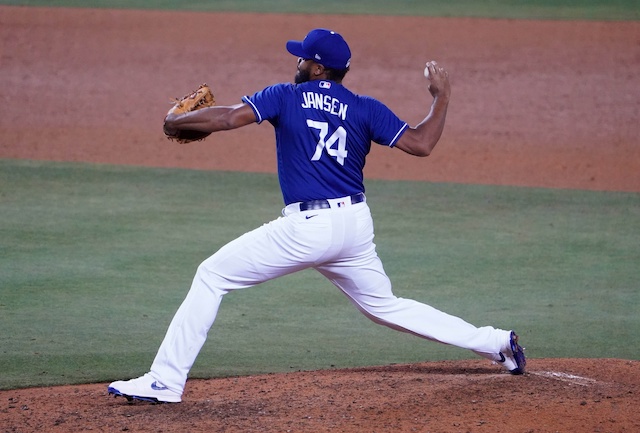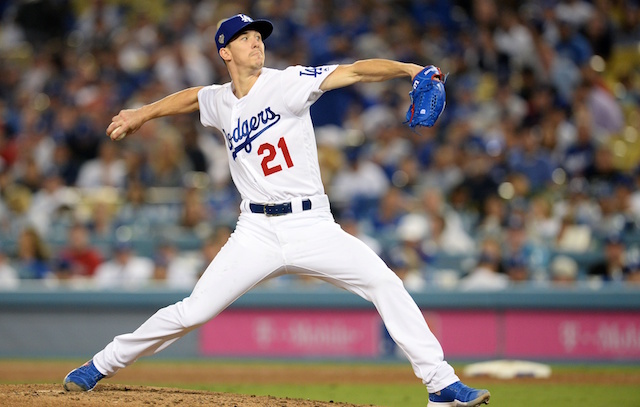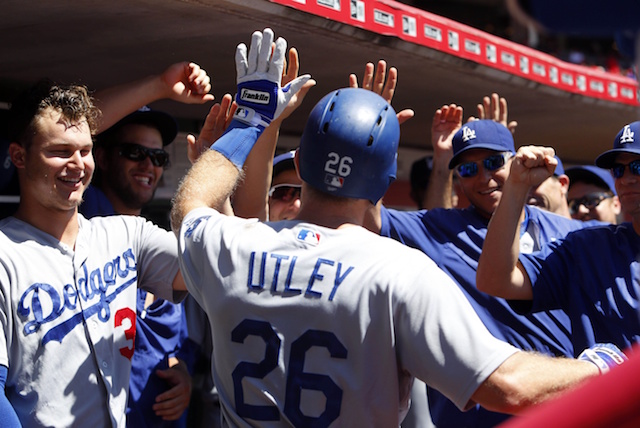Admittedly this is a ridiculous exercise, bathing itself in small sample size and ridiculous speculation. And yet… here we are. After watching the Los Angeles Dodgers in Summer Camp, optimism was at an all-time high.
Granted, some of that dissipated with back-to-back losses to the San Francisco Giants at the end of the Opening Series. Nevertheless, the lineup had stretches in which it mashed, and the starting pitching showed some of its depth.
The question -— as always, it seems -— is the Dodgers bullpen. But if Summer Camp and the first two games of the regular season were any indication, hopes might be as high as ever. And for those that follow the team closely, it makes sense considering the Dodgers made two of the most high-profile bullpen moves they have made in years: signing Blake Treinen and trading for Brusdar Graterol, while losing nobody from last year’s group.
Also, it’s worth noting that the Dodgers’ bullpen probably gets too bad of a rap from last season. In the end they had the fifth-best ERA (3.85) and posted the ninth-most wins above replacement (despite being 27th in innings pitched).
But hey, enough with the actual statistics, right? Let’s get to some wild speculation.
The exercise is simple: if you could fast-forward a couple of months to the end of the regular season, how would the bullpen arms be ranked? (This is excluding Dustin May and Tony Gonsolin because of their likelihood to be starting at some point).
Again, to be clear, this isn’t a ranking of players today, but for the end of the regular season. Sometimes logic will be involved, and other times probably not. But enough with the explaining, let’s get into it.
1. Blake Treinen
Blake Treinen, “Get Me Over” 1st Pitch Ridiculous Sinker. 😯 pic.twitter.com/apGIh1q1Ui
— Rob Friedman (@PitchingNinja) July 21, 2020
Blake Treinen, Unfair Sliders. 😳
🚫🧙♀️ pic.twitter.com/428ChR3ErM
Off the top, placing Treinen at No. 1 after few good outings against one of the worst teams in the league can certainly be questioned. But in an exercise about pure speculation, why not?
Let’s remember that Treinen isn’t an unproven commodity. In 2018, he was striking out 11.20 batters per nine innings (31.8 K%), his ERA was 0.78, his WHIP was 0.83 and he did all this over 80.1 innings (38 saves).
In 2019, it was a different story, but Treinen is chalking that up to nagging injuries and breakdowns in mechanics —- both things he claims are cleaned up now.
2. Brusdar Graterol
Brusdar Graterol, 101mph and 99mph Fastballs (and Sword). 🔥⚔️ pic.twitter.com/7xnI0VyDBp
— Rob Friedman (@PitchingNinja) July 21, 2020
In closing out the game, Graterol made nine pitches: six four-seam fastballs, two sliders and one sinker. The fastballs came in at 99.1, 99, 99.6, 99.4, 98.5 and 98.7 mph. The sliders? 88.9 and 89.7 mph. The sinker? 100.5 mph.
The kid is 21-years-old. Give me the upside play here.
3. Kenley Jansen
Some will be shocked to see Jansen this low, hile others probably think this is too high. Welcome to the 2020 Kenley Jansen Experience.
To be clear, Jansen isn’t bad. He just isn’t what he used to be. From 2012-2017 Jansen was an elite reliever no matter how you looked at it.
After a down year in 2018 (4.03 FIP, lowest K/9 and highest HR/9 of career and just 0.3 WAR), Jansen bounced back a bit last season (1.2 WAR, 3.48 FIP) — albeit while blowing the most saves of his career (eight). For context, he blew nine saves total from 2015-2017.
Jansen has already given us a glimpse of what 2020 will likely be. On one hand, he been effective at times, but also struggled to consistently hold his velocity over 90 mph.
Dodgers manager Dave Roberts has emphasized the key for Jansen is not velocity, but cutter movement — something he claims has looked good thus far. And who knows, maybe the velocity will tick up a bit once Jansen gets more pitching under his belt having recovered from COVID-19, causing a late arrival to camp.
Either way, Jansen isn’t the alpha dog he once was. And by the end of this season, that might become really clear.
4. Pedro Baez
While the 32-year-old Jansen’s trajectory is headed in one direction, Baez has actually seen his career go the other way —- posting his best season to date in 2019.
In 71 appearances, Baez posted a 3.10 ERA (3.52 FIP) and 1.3 WAR last season. While never flashy or totally reliable, Baez has been consistent and a really solid arm in the bullpen. If he’s your fourth or fifth best option, that’s a sign of a really good bullpen.
5) Joe Kelly
There’s a case to be made for Kelly being higher on this list, but that won’t happen here. Kelly’s first year in L.A. was an unmitigated disaster, but 2020 is a new year and the Dodgers are hoping he regains the form he had against them in the 2018 World Series.
The problem? He’s posted an ERA under 4.39 just once since 2013 (that was in 2017). Of course, the peripherals have always been there as Kelly has pitched to a FIP under 3.80 the last three seasons.
Consider this, last season when the ball was put into play against Kelly, hitters had a batting average of .323. The year before it was .301. Baez, who ranks just ahead of Kelly on this list, had hitters it .213 on balls in play last season (and .286 the year before).
Historically we would call this incredibly bad luck for Kelly (and good luck for Baez) — unless the eye test says otherwise, and with Kelly, it has.
6) AJ Ramos
Hey, if we’re throwing darts here, might as well lob a big one.
Between 2013 and 2016, Ramos posted an ERA well under 3.00, struck out more than 10 batters per nine innings and saved 72 of 81 opportunities. In 2017 he changed teams, in 2018 he was dreadful (6.41 ERA) and then injured before being out of baseball.
The irony of putting Ramos here is that he might not even make the roster. But if he does…
This pick is all upside. So far — in incredibly limited sample size that features meaningless competition — he’s passing the eye-test (and the numbers test).
AJ Ramos, 92mph Fastball and 84mph Changeup, Overlay. pic.twitter.com/zFxQEI2jmM
— Rob Friedman (@PitchingNinja) July 20, 2020
7) Dylan Floro
At the end of the day Floro is a quality MLB reliever, and there aren’t a ton of those out there.
In 2018, he posted the fourth-lowest ERA in the National League among relievers (2.25) across 64 innings. Last year that number ballooned to 4.24 — although the peripherals tell another story.
Floro’s FIP went from 3.08 to 3.56, while his K/9 stayed basically the same (8.16 to 8.19) and his BB/9 went down (3.23 to 2.70). The problem? The long ball.
In 2018 he saw just 6.1% of his flyballs leave the yard, but last year it climbed to 10.3%. Not good.
And yet, even if he repeated his 2019 season, you’d expect a bit better luck and an ERA right around 4.00 which, well, isn’t terrible.
8) Caleb Ferguson
Speaking of guys who had a rough year in 2019, Ferguson’s name might belong at the top of the list. After a breakout year in 2018 (3.49 ERA in 49 IP), Ferguson struggled with consistency last year, posting a 4.84 ERA and seeing his BB/9 rate more than double (2.20 to 5.44).
Ferguson just turned 24 and with a speed bump behind him, look for the lefty to bounce-back into a solid reliever for the Dodgers this season.
Others to consider
Scott Alexander: A 5.06 FIP last season thanks to a K/9 that dropped to 4.67. He’s probably ninth on my list, but his strikeout numbers are terrifying.
Adam Kolarek: Nobody’s career was more hurt by the MLB’s decision to change the rules about minimum number of hitters faced. Kolarek simply can’t get righties out on a consistent basis.
Have you subscribed to our YouTube channel? It’s the best way to watch player interviews, exclusive coverage from events, participate in our shows, and more!








